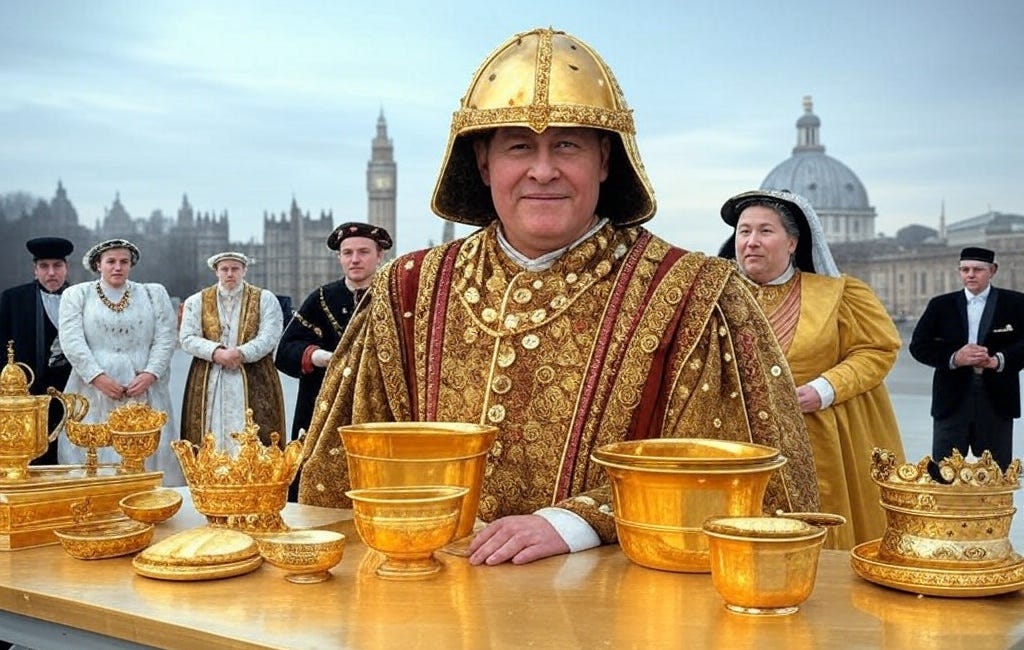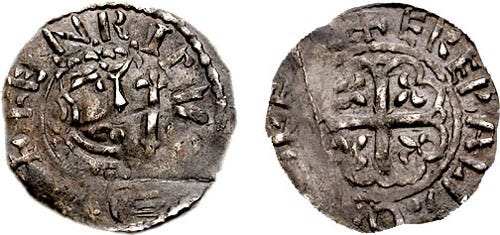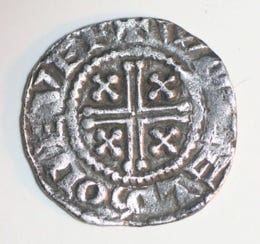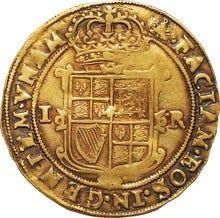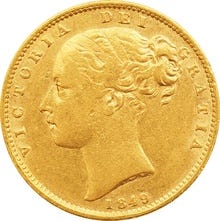Key coinage laws/acts/events in the UK since 1066
This post explores the various coinage laws that have existed in the UK since 1066. Some are certainly better than others. Let's travel through time and have a look
Today’s post is going to look at some of the key laws over time in the UK that have either helped or hindered the relationship with gold, silver and monetary standards in general.
If you are yet to read any of the other historical pieces, then I’d highly recommend that you add them to your reading list.
We started at the Bronze Age and gave a 5,000-year overview of these shores and gold.
History, Britannia & Gold: A Journey through time
The world has long had a love affair with Gold and everything that it can offer.
We then explored ''The Golden Era - The British Empire & Sound Money between 1816 - 1914''.
The Golden Era - The British Empire & Sound Money between 1816 - 1914
Today’s post is going to dive into the history of Britain and specifically look at the Golden Era between 1816 - 1914. This was a time when the sun never set on the British Empire and, because of sound monetary policy, inflation was relatively non-existent.
And finally came up to the present day when we looked at the intertwining relationship between the UK & Gold between 1914 - 2025
The United Kingdom and Gold: 1914 - 2025
Today’s post is going to look at the intertwining relationship between the United Kingdom and Gold from 1914 to the present day. It is a follow on from the popular article ''The Golden Era - The British Empire & Sound Money between 1816 - 1914''.
Talking of Gold, our sponsors at Polymarket have the odds of gold finishing 2025 above $3,200 at 57%. This is a 5% drop from the last time we checked in with this market. You can keep up to date with this market here.
Key coinage laws/acts/events in the UK since 1066
In order to make this article as fluent and as consistent as possible, the laws/events are in chronological order and a brief description has been included too. 1066 (Norman Conquest/Battle of Hastings) seemed like a good place to start, so that is indeed where we will start.
I have included the reigns of the monarchs in brackets where applicable and have provided a Wikipedia link to them just in case you would like to read more about them.
Not EVERY single law/act of parliament is included, otherwise this post would have been much longer!
1066-1087: Norman Conquest – William I’s Coinage
King William I (1066 - 1087) kept the Anglo-Saxon silver penny as England’s main money. The various mints operated under strict control throughout this time in order to ensure quality consistency. Any counterfeiting was treated very harshly (mutilation) and this helped to maintain trust throughout the conquerors reign.
1087-1100: William II’s Coinage
King William II (aka William Rufus) continued using silver pennies with minimal changes. His reign between 1087 - 1100 saw no major coinage laws implemented but the minting remained centralised throughout. William II and his government were not as strict as those of his father (William I), so coin quality varied throughout his reign.
1100: Henry I’s Coinage Reforms
King Henry I (1100 - 1135) tightened control over mints to standardize silver pennies. Henry was very much like his father, ruling with an iron fist. Counterfeiters faced severe punishments and regular reissues of coins helped to maintain quality throughout his reign.
1135-1154: Stephen’s Reign
Civil War (aka The Anarchy 1138 - 1153) led to decentralized minting, with barons and princes issuing their own coins, just like the one Prince Henry of Scotland produced following a peace deal with King Stephen (1135 - 1154).
As a result of pretty much continual chaos throughout this period, royal control over monetary matters weakened significantly and this caused inconsistent standards. Silver pennies remained the main coin throughout this time.
Source and thanks to Classical Numismatic Group, Inc. http://www.cngcoins.com
1158: Henry II’s Coinage Reform
In 1158, King Henry II (1154 - 1189) introduced the Cross-and-Crosslets silver penny in order to restore uniformity and to get the poor and inconsistent coins during Stephen’s reign out of circulation.
These Cross-and-Crosslets were later known as Tealby pennies due to a find at a place called Tealby (Lincolnshire) in 1807.
Royal mints were reorganized under royal authority to improve quality and the aim of this was rebuild trust after years of instability. Unfortunately, the quality was not consistent and the coins turned out to be poorly minted overall.
1180: Short Cross Penny
We’re still in the reign of King Henry II and after many issues with coin clipping, Philip Aimer looked to reform and standardise the design of the silver penny.
A short cross pattern was introduced. This made the silver pennies both harder to clip and more recognisable. This design was in use for nearly 100 years.
1247: Long Cross Penny
Despite the Short Cross penny being more easily recognisable, clipping was still an issue. Therefore, in 1247, King Henry III (1216 - 1272) introduced long cross pennies to try and combat this issue.
The cross extended to the edge of the coin (good idea) and this made it easier to see if any metal had been removed. This reform improved trust.
In 1257, a gold “Penny” with a value of 20 pence was issued following the introduction of gold coinage in some Italian states. This coinage turned out to be unsuccessful.
1279: Edward I’s Coinage Reform
King Edward I (1272 - 1307) issued new silver pennies, halfpennies, and groats with improved designs. The minting standards were tightened to ensure consistent weight and purity throughout. This reform helped to strengthen the money system in England.
1340: Edward III’s Debt Default
King Edward III (1327 - 1377) - still probably the most underrated king in English history in my opinion, defaulted on the sovereign debt in 1340. I would highly recommend listening to this documentary (link below) about this event.
BBC Radio 4 - The Long View, Sovereign Debt and Default
1344: Edward III’s Gold Coinage
King Edward III (1327 - 1377) did introduce gold florins, nobles, and half-nobles to England. These were the first major gold coins introduced in England and were used mainly for trade. Silver pennies remained and were the primary money for everyday use.
1351: Statute of Purveyors/Provisors
The 1351 Statute of Purveyors/Provisors (there seems to be a dispute about what this was actually called) saw a major coinage reform in England. In this statute, strict weights and standards for gold and silver coins were implemented. There was also an export ban on precious metals. This law was aimed to stabilise the economy and to help protect the wealth of England during the Hundred Years’ War (1347 - 1453).
1422-1461: Henry VI’s Coinage
Henry VI (1422 - 1461 & 1470 - 1471) maintained gold nobles and silver pennies, but economic issues, including multiple wars and King Henry VI likely being ‘simple’ to put it politely, led to multiple debasements throughout his reigns.
As a result, coin quality was poor and the only consistency with the coinage was the inconsistency itself.
1464: Edward IV’s Coinage Reform
King Edward IV (1461 - 1470 & 1471 - 1483) introduced gold ryals and angels. The weight of the silver penny was also reduced. All of this was done in order to align the currency system of England with that of Europe.
Gold started to become more prominent in high-value transactions within the country i.e. high-level estate purchases.
1489: Henry VII’s Sovereign
Arguably the best fiscal sovereign that England has ever seen was King Henry VII (1485 - 1509). He issued the first gold sovereign in 1489. This had a nominal value of pound and one shilling, was 23-carat gold and weighed half a troy ounce. This coin really helped to put England on the international map.
Silver and gold coin weights were standardized for consistency.
1526: Henry VIII’s Debasement
From one of the best fiscal sovereigns to one of the worst. King Henry VIII (1509 - 1547) began reducing the silver content in coins to fund wars. We also saw the utter and needless extravagance with the Field of the Cloth of Gold in 1520.
Gold crowns and half-crowns were introduced, but with lower purity, thus debasing the currency. This eroded public trust. But the worst was yet to come.
1544: Great Debasement
The Great Debasement between 1544 - 1551 was initiated by King Henry VIII and saw the dramatic decrease in the amount of precious metal in the gold and silver coinage.
Gold standards dropped from 23 karat to 20 karats and silver content reduced from 92.5% to just 25%. In some cases, silver coins were replaced entirely with copper.
It was not just wars that were causing this issue. Continual overspending by the King led to this issue. The King needed and wanted more income, and the main aim of this policy was to provide that.
Without a doubt, the coinage became less valuable. Trade and trust were disrupted, and the economy went through some very hard times.
NB - This is, in my opinion, arguably the worst law/act that ‘England’ has ever passed. All to fund essentially needless wars with France and Scotland whilst at the same time funding an excessively lavish lifestyle for a King that had already done enough damage in his reign.
1551: Edward VI’s Restoration
The Great Debasement was revoked in 1551 by King Edward VI (1547 - 1553), who attempted to restore silver purity in coins by issuing fine silver shillings. Unfortunately, the economic circumstances at the time halted much of the progress. Financial pressures also contributed to the lack of progress but at least Edward had made a prudent decision.
1560: Elizabethan Coinage Reform
At the start of Queen Elizabeth I (1558 - 1603), faith in the money system was very low. Trust was non-existent and something needed to be done very quickly. The 1560 Coinage Reform helped to restored silver purity. It also helped that between 1560 - 1561, ALL of the debased money within the system was removed.
This solution was a result of the Queen working very closely with 2 key advisors, William Cecil and Thomas Gresham (yes, this is where Gresham’s law comes from).
Milled coinage techniques were introduced and this led to better precision and quality.
This consistency helped to build back trust with the people and helped to stabilise the economy for a long time. This era has since become known as the Elizabethan Era.
NB - Given the Great Debasement and the subsequent Elizabethan era, the 1560 Elizabethan Coinage Reform was arguably the single most important law/act that England has ever enacted. The crown even made a healthy £50,000 by taking all the old coinage out of circulation!
1604: James I’s Coinage
King James I (1603 - 1625) standardized gold unites (picture below) and silver shillings for consistency. Foreign coins were banned in order to try and protect England’s currency. This reform helped to support the growing international trade.
1663: Coin Act
King Charles II (1660 - 1685) introduced machine-struck coins for uniformity and efficiency. The gold guinea was struck in England between 1663 and 1814, contained approximately 1/4 ounce of gold and became a key coin for trade.
The machine-struck coins meant that hand-struck coins were phased out and this helped to modernise the minting process.
1717: Sir Isaac Newton’s Gold Standard
As Master of the Mint, Sir Isaac Newton fixed the gold guinea at 21 shillings in 1717. This meant that Great Britain entered into a de facto gold standard and thus prioritized gold over silver.
The reform did though help to stabilise England’s currency for international trade.
1816: Coinage Act
One of the most important acts in relation to gold that the UK has ever implemented. In 1816, the gold standard was formally adopted. The sovereign was the main coin.
The Act itself defined the value of the pound sterling relative to gold. Silver coins became subsidiary and were not allowed to be used for transactions larger than 40 shillings. The silver coins would also be reduced in weight from 66 shillings down to 62 shillings.
The reform modernized the monetary system of Great Britain and helped to greatly improve trade.
1849: Gold Sovereign Standardized
Trade was continuing to fuel the British economy and the gold sovereign continued to anchor the monetary system. In 1849 it was standardised. This helped to ensure reliability for global trade. Silver coins still had their for day to day purposes.
1870: Coinage Act
The Victorian Era was a very prominent era. The 1870 Coinage Act maintained the gold standard and consolidated all the existing coinage laws that were in place.
Silver and bronze coins were also standardised and continued to be used for smaller transaction. This Act ensured ongoing stability in the British monetary system and also helped with the continuing booming international trade.
1914: Gold Standard Suspension
The Gold standard would not last though as World War I led to the withdrawal of gold coins from circulation. The gold standard was suspended in order to help with the war efforts. Gold was effectively replaced with a paper currency for everyday use.
1925: Gold Standard Act
In 1925, the United Kingdom briefly returned to a gold bullion standard. Countries could hold gold, dollars of pounds as reserves. The two exceptions were the USA and UK, both of whom only held reserves in gold.
However, returning to a gold bullion standard at pre-war rates (£1 = $4.86) overvalued the pound, lead to the 1926 General Strike, hurt exports, caused economic strain and led to the 1931 collapse. Not Sir Winston Churchill’s finest hour. leading to its 1931 collapse.
This marked the end of gold-based currency in practice.
1971: Decimalisation Act
In the same year as the Nixon shock, the United Kingdom switched to a decimal currency. This divided the pound into 100 pence. As a result of this, old coins such as shillings and pennies were phased out.
This reform helped to simplify and modernise the monetary system.
1999 - 2002: Browns Bottom
Gordon Brown decided to sell half of Britain’s gold (at the lows) between 1999 - 2002 in order to ‘diversify the assets of the UK's reserves away from gold, which was deemed to be too volatile’.
Roughly half of the holdings (395 tonnes, 12,700,000 troy ounces) were sold between 1999 - 2002 at a total price of $3.5 billion (about $275 an ounce). With gold circling $3,300 at the time of writing this article, it is safe to say that the United Kingdom would have been much better off fiscally by holding on to their reserves.
$3,300 x 12,700,000 = $41.91 BILLION (£31.66 BILLION using todays exchange rates).
Summary
There have been many bad Kings and Queens both before and after 1066. There have also been a lot of coinage laws enacted over the years as well.
Although it is very easy to pick on Gordon Brown and the selling of the reserves between 1999 - 2002, it has to be said that the worst decision of them all would have been that of the Great Debasement under King Henry VIII. Famed for having 6 wives, all I can say is that if his fiscal abilities were as good as his changing of wives, then the Tudor period of England could have turned out much differently.
It would also be easy to point to the Coinage Act of 1816 as the best law enacted but I will go with the Elizabethan Coinage Reform of 1560 for 2 reasons. 1 being that the swift action from the Queen and her advisors ultimately led to one of the greatest periods of history in England (easy to say in hindsight). 2 being that we now have Gresham’s Law i.e. bad money drives out good money.
The fact that Elizabeth I was able to undo all of her father’s greed and fiscal indiscipline, with swift action and good advisors, means that the 1560 reform is at the top of my list for most successful coinage act ever enforced on these shores.
If you liked reading this post and believe that others in your social network will enjoy reading it, then please restack/reshare it




